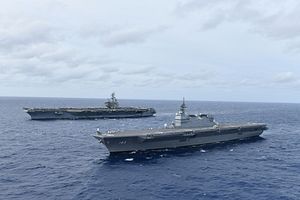The U.S. Navy Nimitz-class nuclear-powered aircraft carrier USS Ronald Reagan and the Japan Maritime Self Defense Force’s (JMSDF’s) largest flattop, the first-of-class JS Izumo, jointly held a naval exercise in the South China Sea from June 10 to 12, the U.S. 7th Fleet said in a statement.
The Ronald Reagan carrier strike group (CSG) and the Izumo carrier group, which consists of the Murasame-class destroyers, JS Murasame and JS Akebone, as well as five military aircraft, “participated in a cooperative deployment,” according to the U.S. 7th Fleet.
“Reagan, Akebono, Izumo, and Murasame conducted communication checks, tactical maneuvering drills, and liaison officer exchanges designed to address common maritime security priorities and enhance interoperability at sea,” the statement said.
The JS Izumo’s annual Indo-Pacific deployment began April 30 and runs through July 10. During its operational deployment, the Japanese flattop and its escort are engaging with the naval forces of Brunei, India, the Philippines, the United States, Vietnam, and Singapore, among others. As I explained:
Last month, ships of the Indian Navy engaged with the JS Izumo and JS Murasame in an anti-submarine warfare (ASW) drill in the Andaman Sea.
The Indo-Japanese drill was preceded by a JMSDF-U.S Navy cooperative deployment in the Malacca Strait involving the USS William P. Lawrence, a U.S. Navy Arleigh Burke-class guided-missile destroyer, the JS Izumo, and the JS Murasame on May 22.
The two JMSDF warships also participated in a multilateral naval engagement between May 2 and May 8 in the South China Sea.
U.S. President Donald Trump toured the JS Izumo’s sister ship, JS Kaga, at the Yokosuka naval base south of Tokyo, together with Japanese Prime Minister Shinzo Abe last month. Yokosuka is also the home port of the USS Ronald Reagan.
The two Izumo-class carriers are the JMSDF’s largest surface combatants each displacing around 27,00 tons when fully loaded. The flattops have been principally designed for anti-submarine warfare (ASW) operations. In December 2018, the Japanese cabinet approved the conversion of the two warships into full-fledged aircraft carriers capable of launching the F-35B, the vertical or short takeoff and vertical landing (STOVL) variant of the F-35 Joint Strike Fighter.
The USS Ronald Reagan, the only forward-deployed U.S. Nimitz-class supercarrier, departed the U.S. naval base in Yokosuka, Japan on May 22 for its first operational deployment of 2019. Last year’s regularly scheduled patrol of the Ronald Reagan CSG began on May 29.
Each CSG usually consists of up to 12 surface combatants including Arleigh Burke-class guided-missile destroyers, Ticonderoga-class guided-missile cruisers, and one or two nuclear-powered fast attack submarines, as well as up to 75 aircraft. The carrier’s air wing reportedly joined the Ronald Reagan CSG at sea.

































